How to Scale a Recipe for Cake to Fit Any Pan
Customizing a recipe for different cake sizes is easy if you ask the right questions.

Serious Eats / Vicky Wasik
The best thing about cake is that it comes in many forms. You can serve it stacked in any number of layers, molded by a classic Bundt pan, as paper-wrapped cupcakes, or simply as a single thick slab. But there is one problem: Most cake recipes are written with directions tailor-made for a specific pan.
Fortunately, most any batter can be baked off in different forms, from a big cast iron skillet to a half sheet pan, or simply layers of a slightly different size than the ones dictated by a recipe. Altering your approach has less to do with science than intuition, but I've done my best to extrapolate some rules of thumb from my own experience (which includes hundreds of wedding cakes in every shape and size).
The trick is asking the right questions to get the answers you'll need to make the right amount of batter for a given pan and avoid common problems (is that stand mixer even big enough to hold a double batch???), while estimating a reasonable bake time for the cake in question.
It's a lot to take in, but with a little practice and care, you'll be able to adapt most any cake to whatever pan you like.
Question 1: Is the Pan Itself Important?
Most cake batters are baked in standard pans, such as those in our guide to cake pans, and are fairly amenable to adaptation when it comes to different shapes and sizes.
But some cakes have unique structural considerations that warrant a special sort of pan— angel food cake, for instance, should be baked in a natural aluminum tube pan.
If you're looking at a recipe that calls for a specialty pan, chances are it's baked that way for a reason, and there may be unforeseen consequences in trying to reformat it. This is especially true for cakes with unusual formulas or unusual techniques.
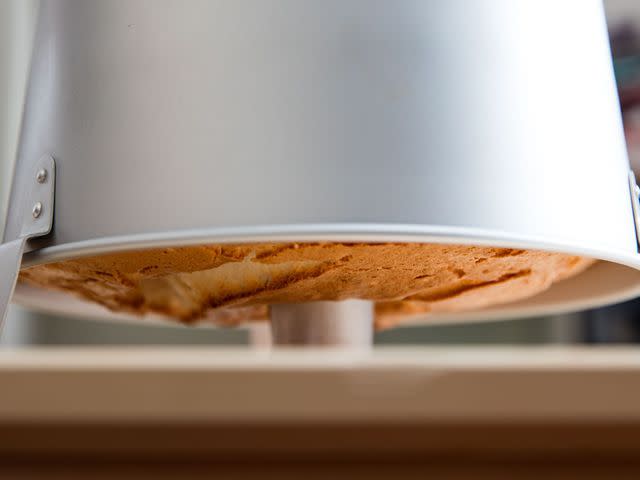
Serious Eats/ Vicky Wasik
Again, consider that angel food cake: It's a fat-free sponge cake made from whipped egg whites that has to be cooled upside down. Or think of cheesecake: It's a flourless concoction of cream cheese, sugar, and eggs, generally baked in a loose-bottom or springform pan and submerged in a water bath.
While adapting these wildcards may certainly be possible, those techniques are beyond the scope of this article, which will remain focused on more traditional cakes—think along the lines of classic vanilla butter cake, devil's food, gingerbread, and carrot cake, and other closely related styles.
Question 2: How Much Cake Batter Do I Need?
Cake pans come in a near infinite number of sizes and shapes, and while the general rule of thumb is to fill a pan between one-half and two-thirds of the way full, who's to say how many cups of batter that will be? And even if a baker were to fill a pan with water, one cup at a time, to determine its capacity, no recipe includes a yield in terms of batter volume.
But it's easy enough to tally up the ingredients to determine the overall batter weight in a given recipe. For that reason, I've learned to think of my own pan-to-batter ratio in terms of weight rather than volume. My approach isn't based on science, but rather the sort of intuition a baker can draw on after amassing enough data points over the years.
It's also worth noting that my methods are influenced by personal preference, in terms of both aesthetics (I like thick cake layers) and culinary style (I generally work with comparatively dense American cake batters, rather than airy European sponges).
Round and Square Pans
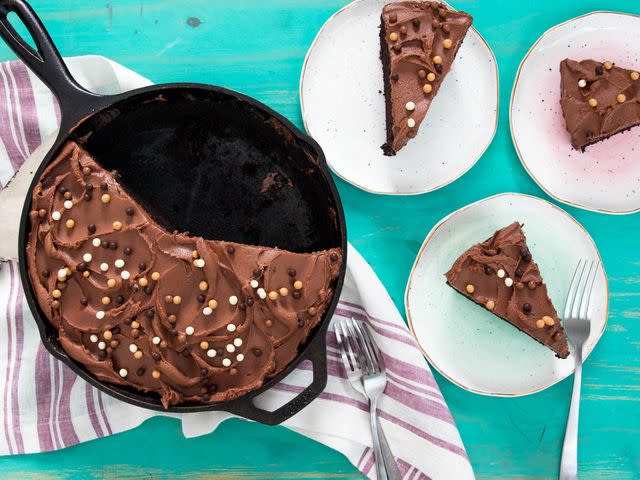
Serious Eats / Vicky Wasik
For round and square cake pans at least two inches deep, I multiply the area of the pan by 0.45 to determine the approximate amount of batter needed. For that, I have to pull out that ol' grade school pun, "pie are square" (πr2), where r is the radius of the pan.
Layer Cake Formula: Area x 0.45 = approximate weight of batter (in ounces)
For example, a 10-inch cake pan has a radius of five inches, so πr2 is 3.14(25), or 78.5. Multiplied by 0.45, I get a batter estimate of 35 ounces. It's fairly elementary math, and the reward is cake, but for those less inclined to do calculations, here are the estimates for the most common pan sizes.
6-inch round: about 12 ounces batter
8-inch round: about 24 ounces batter
8-inch square: about 28 ounces batter
9-inch round: about 28 ounces batter
10-inch round: about 35 ounces of batter
2-inch cupcake: about 1 3/4 ounces batter
Brownie Pans

Serious Eats / Vicky Wasik
For rectangular pans at least two inches deep, I multiply the area of the pan by 0.37 to determine the approximate amount of batter needed. To find the area of a rectangle, simply multiply the length of the pan by its width.
Brownie Pan Formula: Area x 0.37 = approximate weight of batter (in ounces)
For example, the area of a nine- by 13-inch brownie pan is 9 x 13, or 117 square inches. By multiplying 117 by 0.37, I get a batter estimate of 43 ounces of batter.
Sheet Pans

Serious Eats / Vicky Wasik
For shallow, rectangular pans such as traditional half-sheet pans, quarter-sheet pans, and so on, I multiply the area of the pan by 0.3 to determine the approximate amount of batter needed. To find the area of a sheet pan, simply multiply the interior length and width of each side.
Sheet Pan Formula: Area x 0.3 = approximate weight of batter (in ounces)
Half-sheet pan: about 54 ounces batter
Quarter-sheet pan: about 26 ounces batter
Bundt Pans
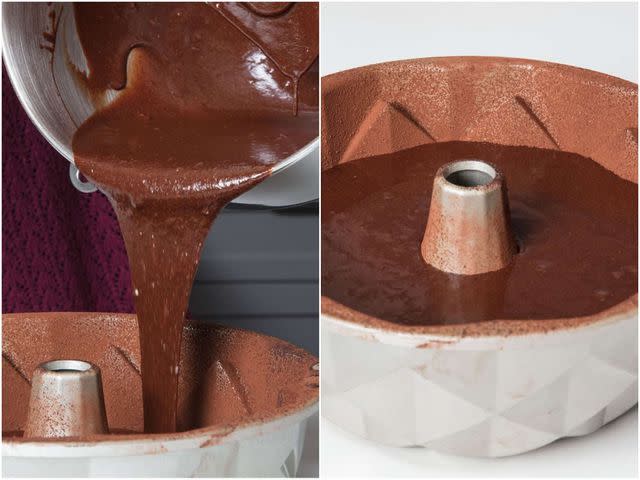
Serious Eats / Vicky Wasik
To adapt recipes to Bundt pans, I multiply the capacity of the pan in cups by 4.2 to determine the approximate amount of batter needed in ounces. If the capacity is unknown, you can place the pan in the sink and fill it with water, one cup at a time, until it's filled.
Bundt Pan Formula: Volume (cups) x 4.2 = approximate weight of batter (in ounces)
Classic 10-cup Bundt: about 42 ounces batter
There's a degree of flexibility involved with scaling any recipe, based on the goal and purpose of the cake, the depth of the pan, and personal preference, along with the logistics of scaling (more on that in the next section).
That said, both under- and over-filling a pan can cause problems of their own, so it's best not to veer more than two or three ounces above or below the estimated amounts. An under-filled pan may produce a low-volume cake that's crusty and tough or dry, while an over-filled pan may produce a cake that's dense and a bit sunken in the middle, or with a weirdly warped crust (even if it doesn't overflow outright).
Question 3: How Should I Scale the Recipe?
To determine the batch size needed for a given cake, divide the total weight of ingredients in the original recipe by the total weight of batter needed.
New ÷ Original = Multiplier
For example, let's say I want to make a batch of my three-layer devil's food cake (70 ounces batter) as a single, 10-inch cast-iron skillet cake.
Based on my own rule of thumb, a 10-inch round pan requires about 35 ounces of batter. Divide that new amount by the original amount in the recipe (70), and we get 0.5 as a multiplier—essentially making it a half batch.
In other cases, the math isn't quite so tidy, and you may be left with a fraction of an egg. Broadly speaking, the pros of beating up a whole egg to scale out exactly what you need vastly outway the cons.
As far as I can tell, the cons relate to the emotional agony bakers experience in pouring 0.42 ounces of egg down the drain, or else the annoyance and absurdity of storing and refrigerating less than a tablespoon of beaten egg in order to give it purpose in their breakfast scramble.
That said, there may be times when scaling a recipe around the egg makes sense. For example, let's say I wanted to make my three-layer toasted sugar and brown butter cake layer cake (82 ounces) as a single eight-inch layer for a Neapolitan cake.
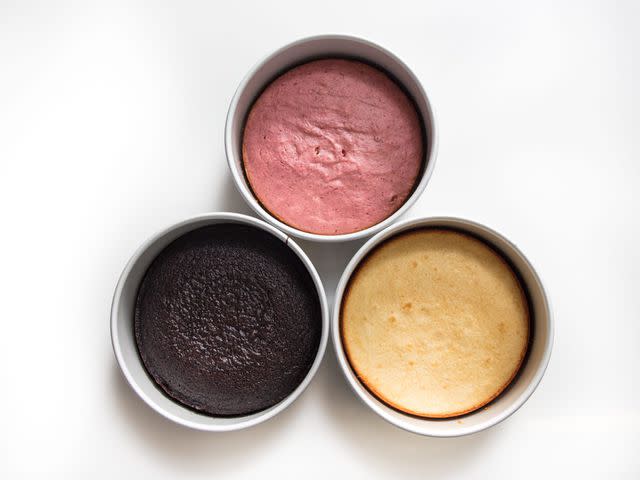
Serious Eats / Vicky Wasik
Based on my own rule of thumb, an eight-inch round requires about 24 ounces of batter. Divide that new amount by the original amount in the recipe (82), and we get 0.29 as a multiplier. This means we'll need 2 ounces of egg, which unfortunately works out to about 1.16 large eggs.
We could round down and hope for the best, or try and sneak by with some other trick (a jumbo egg? A little extra water?). Or, we could look at a recipe that calls for 4 whole eggs and decide that 0.25 would be a more convenient multiplier, resulting in a one-egg cake. At 20 ounces of batter, it's a little below average in terms of my own ideals, but the ease and convenience of that batch size may also be worthwhile to many bakers.
Please bear in mind that the new recipe will involve timetables of its own, and the physical cues in the recipe will always take precedence over the ballpark figures listed for time—that's true even for the original recipe, but all the more so with a smaller batch.
Question 4: What About Scaling Up?
Whether for the purpose of cupcakes by the dozen, extra cake layers for stacking, or a big sheet cake to feed a crowd, many recipes can be doubled, or even tripled quite safely. This is particularly true for small-batch recipes, where the yield is a single cake layer, such as a my blackberry snack cake or a classic olive oil cake, and other such low-volume affairs.
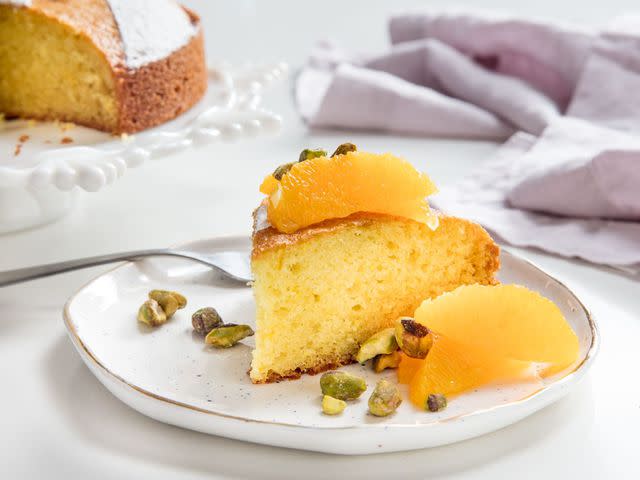
Serious Eats / Vicky Wasik
While some bakers insist there is some mysterious, sidereal calculations required to adjust the leavening agents for different batch sizes, I handle these ingredients with the cool indifference of math alone—this approach has never failed me. Perhaps on an industrial scale it would be of some concern, but so, too, would a number of other issues too numerous and obscure to address here.
The more pressing issue for home bakers is to consider the capacity of their mixer when scaling an already large recipe up. While one may technically be able to cram all the ingredients required for a double batch of something into the bowl, overfilling will both limit the batter's capacity for aeration as well as increase the difficulty of homogenization.
The result is typically a dense cake, and one that may be prone to sinking in the middle, or else streaked with discoloration along the surface, with mottled, uneven textures within (some parts fluffy, some parts gooey; some light, some dark).
I try to fill my six-quart stand mixer with no more than 85 ounces of cake batter when using the creaming method; perhaps a little more for cakes that involve folding in some bulk of the ingredients by hand.
With smaller stand mixers, that amount will be reduced according to the capacity of the bowl; to roughly budget capacity, allow about 14 ounces of batter for every quart the bowl can hold. Hand mixers (and hand mixing) can be a bit trickier to judge, as their effectiveness depends on the volume-to-surface area ratio of the batter in the bowl (ideally, the batter would not be able to engulf the beaters or whisk).
So tally up the ingredients list before doubling a recipe, and make sure the amount of batter won't be overwhelming to the functionality of the equipment involved. The safest option may be to make two individual batches of batter, rather than one double batch.
Question 5: How Can I Avoid User Error?
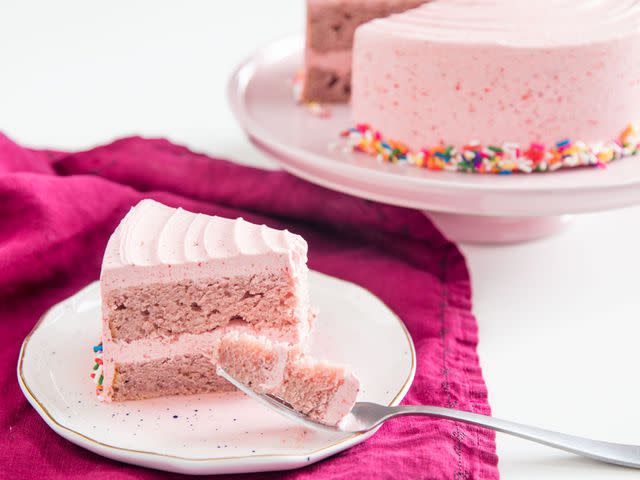
Serious Eats / Vicky Wasik
I can't say how many times I've personally screwed up a cake by doing the math in my head, and how often I've solved a troubleshooting issue for readers by asking, "Did you make a half or double batch?"
Whether scaling up or down, always write the new recipe down before jumping in. All it takes is a moment's inattention to accidentally include one ingredient at the original amount, almost always resulting in catastrophic failure.
I've been there myself, on more occasions than I'd care to admit, and I do this for a living! No matter how careful a baker may be, on-the-fly mental calculations are risky at best, and, chances are, mistakes will be made. Maybe not today, but eventually. Inevitably.
Question 6: How Should I Adjust the Oven Temperature?
This one's simple—don't touch that dial. Whatever temperature is listed in the recipe is the best temperature for baking that cake. Period.
Question 7: How Long Should I Bake It?
It's hard to mathematically predict how long a pan of batter will need to bake. The best and safest option will always be to keep a close watch over the cake, and let physical cues, such as color, texture, and aroma, be your guide.
Broadly speaking, cakes will generally be done if they're baked to an internal temperature of at least 200°F, but the margin of error for the thermometer probe placement will vary with the thickness of the cake itself, potentially making it an unreliable method for beginners. If the probe is too near the pan, or else inserted at a shallow angle, the readings may not reflect the cake's doneness.
Still, one can roughly estimate the bake time of a recipe based on the amount of batter and pan style, just to get a general notion of how long it may potentially be in the oven.
Most eight-inch round cakes will bake approximately 1.29 minutes per ounce of batter. Cakes in larger pans will generally bake faster (about .9 minutes per ounce of batter in a 10-inch pan), while cakes in smaller pans will often take longer (up to two minutes per ounce for a 6-inch pan). Meanwhile, cakes baked in a tube or Bundt pan may only need a minute per ounce of batter.
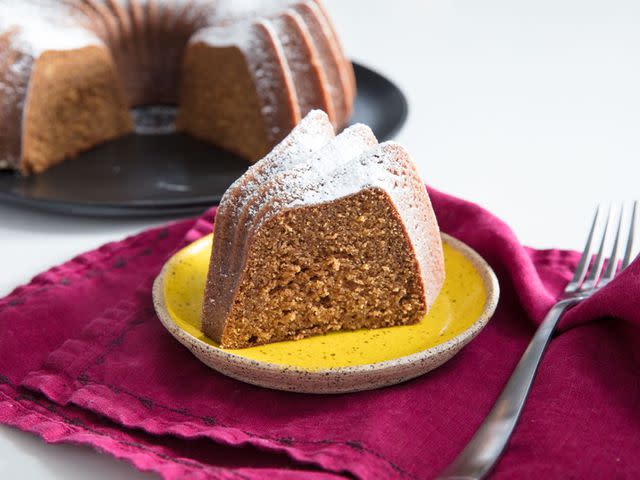
Serious Eats / Vicky Wasik
Remember that the guidelines listed here are sweeping generalizations meant to get bakers into the right ballpark when it comes to batching and baking cakes in different pans. Navigating the details will still require attention to detail, so take your time, make careful notes, avoid substitutions, pay close attention to technique, and always check on the cake as it's baking—well before the timer has gone off.
Take It Slow!
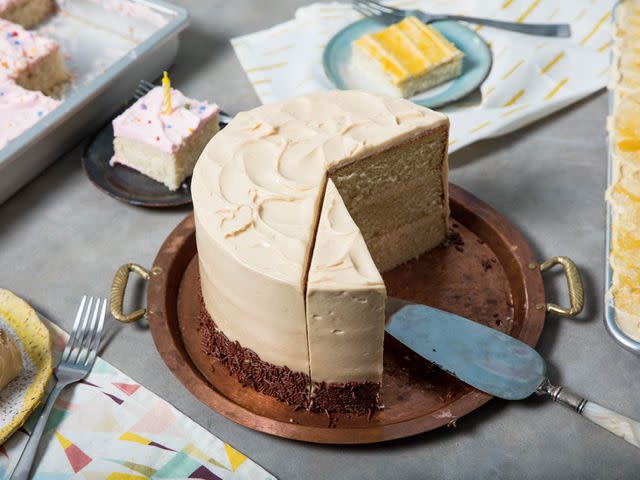
Serious Eats / Vicky Wasik
Successfully scaling a cake to a new batch size and pan requires a number of calculations, with a new opportunity for error at every turn. From there, it still requires the correct ingredients, accurate measurements, and good technique for preparing the batter, along with personal judgement and intuition in baking the cake itself.